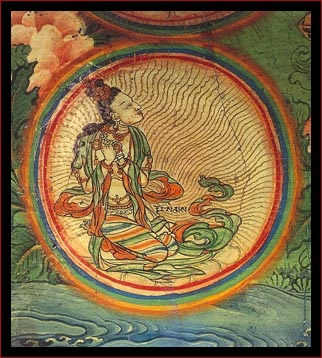



Itís early. Too early. Santa Fe is perpetually on Santa Fe Time, which means that nothing even thinks of happening until it is the right time for it to do so, and those magical occasions rarely happen before noon. But my body has been in so many time zones lately that it no longer knows which one to map to, and has decided to be wide awake at seven in the morning. So here I am at my favorite cafť, sitting at a corner table, sipping a cappuccino and checking out the auras of the other patrons as they glisten in the morning light.
I donít usually see auras or other subtle phenomena. Even in the desert with Rama, I would see only a small percentage of the stuff the other students reported seeing. I guess thatís just my bodyís way of telling me I havenít been paying enough attention to it. But this morning, possibly because it has decided to wake up bright-eyed and bushy-tailed, I am definitely seeing spheres of light around people as they walk by. Cool.
The few times in the past when I could clearly see the energy field around someone, it tended to be pretty monochromatic. With Rama, I would see him surrounded by an intense sphere of golden or white light. With other people, I would occasionally perceive a glow around them, but again it tended to be a kind of shimmery white light, similar to the Aurora Borealis. But this morning, for whatever reason, I am not only able to see people as spheres of light, but am able to see that each of those spheres of light has a definite color.
Itís not like the colors are fixed; in fact, within any particular aura, the colors change, swirling together like paints on an artistís palette. At any given point on the palette, the colors are in a constant state of flux. But when you step back and look at the palette as a whole, there is always a predominant color. Itís like peopleís eyes. If you gaze at them closely, there is an amazing mix of colors - blue, green, black, flecks of yellow and red. Yet there is something about the overall mix of colors that allows you to say, ďHer eyes are green,Ē and smile with the memory of them. Thatís what the auras look like to me this morning - spherical palettes of ever-changing color, swirling by like pilgrims of light on a quest for caffeine. Yet each of these swirling spheres of light has a definite overall color. This womanís aura is primarily green; that guyís is pinkish-red. The older gentleman sitting in the corner has a primarily blue aura. So does his dog. Weird. I wonder what color mine is. Suddenly, laughing aloud at the thought, I find myself wondering whether my aura has a definite color.
Smiling sheepishly in apology to the people startled by my sudden laugh, I find myself remembering a poem by Saint John of the Cross. It was used as the frontispiece to my favorite of the Carlos Castaneda books, Tales Of Power:
The conditions of a solitary bird are five:
the first, that it flies to the highest point;
the second, that it does not suffer for company,
not even of its own kind;
the third, that it aims its beak to the skies;
the fourth, that it does not have a definite color;
the fifth, that it sings very softly.
Typing very softly at my table in the corner, I wonder what color the other people in the room would say my aura is if they could see it. It amuses me to think that they wouldnít be able to come up with one.
Even though I suspect that this morningís experience of being able to see auras is fleeting, I am profoundly grateful for it, because it gives me the opportunity to verify, with my own senses, one of Ramaís core teachings. This one is pretty obscure, even for me. I keep in touch with a number of friends who studied for years with this Rama guy. I have read many of the things that other students have posted on the websites that deal with his teachings. But over the years, not one of them has ever remembered him using this particular metaphor, and that surprises me because when he first said it, it struck me with such force that it has become, for me, one of his core teachings.
Itís funny what people remember and what they donít. Many of these folks were sitting in the same room that I was when he said it, but they didnít take any particular note of it. Maybe itís like the thing I mentioned earlier, that at any given moment in the desert some of us were able to see the flashy phenomena and some of us werenít. Maybe I just happened to be on at the particular moment he said it, and thus it made a deep impression on me, whereas later in the evening the fog rolled back in and I completely missed something that made just as deep an impression on someone else.
Then again, maybe the reason that some people donít remember this particular metaphor is that itís about relationships. The care and feeding of relationships was not exactly a high priority among Ramaís students.
This is understandable. In one phase of his teaching, Rama taught his students the value of spending some time analyzing their interpersonal relationships, especially the transactional nature of those relationships. His suggestion, for those who were serious about the spiritual path and thus had an interest in conserving their energy, was very simple. If you have a long-term relationship with someone, whether that person is a friend or a family member or a lover, every so often it is a good idea to examine that relationship as an exchange of energies.
Ramaís technique for doing this was to sit down alone after spending time with one of these people (not while you are with them), and to closely examine your energy levels. How did you feel before being with the person, and how do you feel now? Do you feel empowered by the interaction or drained by it? If you notice that every time you spend time with one person you come away from the experience feeling stronger, feeling better about yourself, that is important information for the spiritual seeker. However, if you notice that every time you spend time with another person you come away feeling like homemade shit, feeling weaker and less sure of yourself, that is also important information. It indicates a relationship that needs some work - you are losing energy in the exchange, and you have to decide whether that energy loss is acceptable in terms of your self discovery. If it is, fine. If it isnít, his suggestion was that you should either change the nature of the relationship or terminate it for a while.
I think this is good advice, but this energy transaction thing is not the metaphor about relationships that resonated with me enough to become one of my personal set of core teachings. The reason is that, over the years, I saw too many of my friends get stuck in this phase of self discovery, and begin to fear all relationships as potentially draining. If one over-focuses on this aspect of human interaction, it is all too easy to get over-focused on 'losing energy.' It is also easy to get caught in the game of blame: ďI had to break up with my girlfriend/boyfriend because she/he was draining the life out of me.Ē Then it starts to cascade. After dumping the first relationship, the person can begin to question all of their relationships. And since it is so much easier to blame the other person and terminate the relationship than it is to actually transform it, after a while the person can become very isolated.
In my not-so-humble opinion, this isolation is understandable but not the result that Rama intended his teaching to have. I think it was supposed to be a phase, a period of analysis that gave way over time to a more balanced view of human interaction. I think that this kind of analysis was supposed to be a tool, a 'thorn to remove a thorn,' a mechanism for improving oneís life, and was not intended to become a lifestyle in itself. If people become obsessed with losing energy in relationships to the point of having no relationships, they are depriving themselves of one of the most transformational aspects of the spiritual path - selfless giving. Itís kinda difficult to give of yourself when that self never interacts on any significant level with other humans. I saw these tendencies over the years in myself and in my fellow students, and had to continually wrestle with them to retain some sense of balance about the people in my life.
So I was mightily pleased when, sometime in the early Nineties, Rama added a new metaphor to his arsenal of teachings about the nature of relationships. He was talking about auras, explaining that every person is surrounded with a field of energy that reflects not only who and what they are now, but who and what they have been in all of their incarnations. Whether or not we can actually see them, all of us feel the auras of the people we interact with. Some we feel comfortable with; some we do not.
He explained that this was natural, because when you interact with someone, what you are doing is touching their aura, as they are touching yours. As a result, there is a natural mixing and blending of the two fields of energy. Alone, you have a particular field of energy that reflects your inner being and its journey through multiple lifetimes. Alone, so does the person you are interacting with. But when you interact, when you are in a relationship, especially the strong relationships like kinship and love, what happens is a blending of the two auras. This is the point in the talk where he came up with the metaphor I like so much.
He said, ďItís like color wheels,Ē and paused.
ďRemember back in grade school when your teacher was trying to explain colors to you and how they work, the blending of two frequencies of light to produce a third? My teacher had props that she used for this lesson - a couple of circular pieces of colored cellophane, one blue, one yellow. She held them up separately and talked to the class about how each one had a color of its own. But then she took the two wheels of color and held them up in front of the class so that their edges overlapped, creating an intersection that was neither blue nor yellow. The area where the two wheels merged was green.Ē
Rama paused to let the simple demonstration sink in, as if he had just shown it to a class full of grade-schoolers, and then said, ďThat is what relationships are about, the merging of two auras to create a third.Ē
 He
went on to explain that this was a natural process - two fields of energy
seeking equilibrium. ďEach of you has a distinct aura, a field of energy
that surrounds you, that reflects your experience in many incarnations.
When you are alone, your aura has its own individual characteristics,
its own color. Other people have their own auras, with their own individual
characteristics and colors. But when you are involved in relationships,
especially the intense ones, the auras touch. And when you touch the
aura of another person, you enter into their state of attention and
they enter into yours. The auras start to blend, to form something new.
The color of your aura intersects with the color of someone elseís aura
and the result is a third aura with a color of its own.Ē
He
went on to explain that this was a natural process - two fields of energy
seeking equilibrium. ďEach of you has a distinct aura, a field of energy
that surrounds you, that reflects your experience in many incarnations.
When you are alone, your aura has its own individual characteristics,
its own color. Other people have their own auras, with their own individual
characteristics and colors. But when you are involved in relationships,
especially the intense ones, the auras touch. And when you touch the
aura of another person, you enter into their state of attention and
they enter into yours. The auras start to blend, to form something new.
The color of your aura intersects with the color of someone elseís aura
and the result is a third aura with a color of its own.Ē
Rama sighed and said, ďSometimes the color of this composite aura is pleasing, sometimes it isnít. But even when it isnít, itís important to remember that itís no oneís fault. One person isnít good and the other bad. Theyíre just different people, with different karmas and different samskaras and different auras of different colors. If the blending of all these differences produces a color that is not pleasant for one or the other of them, itís not the fault of either of them. It just happens.Ē
I love this metaphor. It is so pure, so non-judgmental, so clean. Two auras touch and their colors blend and fuse with one another. Sometimes the resulting color is pleasing to the senses; sometimes itís not. No blame, either way. Itís no oneís fault. Itís just what happens when auras collide.
Maybe I love Ramaís metaphor so much because it doesnít remain static in my mind like tired old dogma. It grows as I grow, changes as I continue to change. Thatís a good thing for someone like me. I can stretch a metaphor tighter than a frogís ass stretched over a barn door, and I plead guilty of having stretched this one pretty far indeed. I am so weird that I have come to see whole other aspects of the metaphor, aspects that I freely admit Rama may have never intended. Like the one where I tie it in with St. Johnís line about the solitary bird having no fixed color. I say to myself, ďSelf, what if the discomfort we sometimes feel with the new aura that results from touching someone elseís has less to do with the new aura than it does our attachment to the old one? What if the thing we find unpleasant about the experience is change itself?Ē
ďWhat if,Ē I continue, ďby meditating and constantly blowing your assumptions and your attachments to smithereens you could become so fluid in your approach to life that your aura remained in a constant state of flux, and never settled down into a definite color of its own? Would that make interacting with other people easier or more difficult? Would they even notice the difference? Would you? Would this fluidity make selfless giving easier, make it easier to blend with the color of another personís aura, because you have no fixed color in your own?Ē I say silly shit when I talk to myself.
Then again, maybe I love the color wheel metaphor because I live for great conversations, even the ones with myself, and it is useful when trying to explain why. I donít know about you, but when I look back at my life many of its coolest moments centered around conversations, and many of them were first conversations. You know what Iím talking about, right? You meet someone whose aura attracts you in some way, and you exchange words and phone numbers and even flirt a little, but thatís not really a conversation. The first conversation is the one where you get deep and start to really see each other for the first time. Itís the moment, whether you are out in public or alone together in front of the fire, when your auras start playing spin the chakras and get into some heavy petting. The color wheel metaphor comes in handy for me when attempting to surf moments like this. The image of swirling spheres of light blending - striving to find some state of equilibrium - perfectly describes the subjective experience and helps me maintain some sense of balance while I am in the throes of it. Or at least I like to tell myself it does.
I laugh aloud at the last line and look up from the Vaio Te Ching, clicking the Save button first. What next? How do I end this particular set of musings? I gaze around the room and use what is left of this morningís gift of seeing to check out my fellow coffee lovers. The subtle vision thing is definitely beginning to fade, but I can still see each person as a sphere of light. The colors are less vibrant, the boundaries less distinct, but the light is still there. And sure enough, just as Rama suggested, the couples in the room have a larger sphere of light that surrounds the two of them. Itís like their individual auras are a subset of the larger field of energy that they produce as a couple. And each of these larger auras has its own primary color. In some cases, the color of the larger aura seems to resonate well with the colors of the individual auras; in some cases, it does not. One such composite aura is particularly striking. In the center of the crowded room, oblivious to the other people chatting away all around them, a couple of St. Johns students are in the obvious first stages of flirtation and love. It is an utter delight to sit and watch the colors of their auras swirl and blend, developing similarities in color and texture that mirror the similar interests they are discovering in their conversation.
Just then, I look up and see a young woman I have seen here before. She is another of the rare Santa Fe early birds, and is in the cafť often in the mornings, reading a book over her coffee before she goes to work. Yesterday I noticed what she was reading, and because it had been an early favorite of mine, had wanted to ask her whether she was enjoying the book. But Iím kinda shy, and she looked like she was really into it, so I didnít. This morning, I notice with some amusement that I get to see what she looks like as aura. Itís pretty cool, actually.
At this moment, she gets up and walks past me to the counter to ask for a refill on her coffee. As sheís waiting, I smile and say, ďSo how do you like the book?Ē
She says, ďI love the writing, but itís still a bit much of a guy book for me.Ē
ďYeah, Keseyís like that. He was always pretty macho.Ē
ďYeah, thatís the thing. I get the feeling itís harder for women to get into it, because it was written more for other macho guys.Ē
I laugh and say, ďAbsolutely. But sensitive macho guys.Ē
She laughs, too. As we talk, I notice that I can no longer see her aura. I think that maybe itís because Iím sitting too close, so I pause and take a sip of my cappuccino and gaze across the room, trying to catch a glimpse of the two of us in the glass windows of the door. It doesnít help. The auras have lost their brightness and their distinct edges. As I look around the room, all I can see is a big jumble of colors. It looks like the palette of a mad artist, dabs of color blending and mixing with each other together in sweet and beautiful chaos. And in our corner of the room, all I can see reflected in the glass doors is a swirling mass of light, changing so quickly that I canít even see color in it any more. I guess the ability to see auras was just a temporary thing, and my subtle vision is on the fritz again. Oh well. It was fun while it lasted. I shrug and put my cup down and turn to her and continue our conversation, suddenly very interested in what she has to say.
<< Back to
Ramalila.NET
![]() |
|![]() Also
visit Ramalila.COM
>>
Also
visit Ramalila.COM
>>
